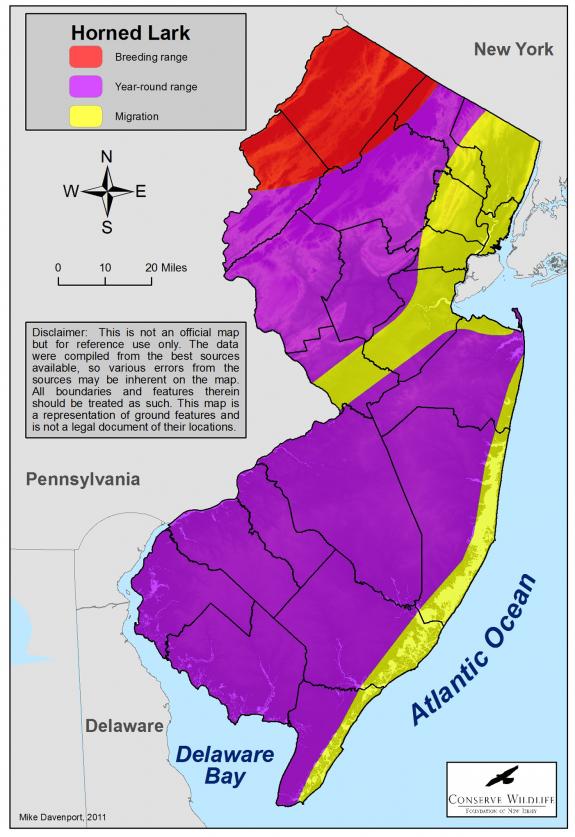Eremophila alpestris
Type: bird
Status: threatened
Species Guide
Horned lark
Eremophila alpestris
Species Type: bird
Conservation Status: threatened
IDENTIFICATION
The horned lark is a small songbird, about 7-8 inches in length with a one-foot wingspan. Its back is brown and its belly is pale. The adult male’s yellow face is marked by a sweeping black stripe below the eyes and another bold black patch below the throat. The horned lark is so-named for the two pointed, black feathery tufts on its head (which can lay flat and are not always seen). In flight, the tail is black with white edges.
Female horned larks are duller in coloration but have the same pattern as males. Juveniles show a muted version of the facial pattern but are otherwise sparrow-like, with a streaked chest and pale spots on the back.
Their song is a high-pitched sequence of musical, staccato tinkling notes (kind of like a squeaky wheel) that grow quicker toward the end of the call.

Distribution & Habitat
Horned larks are the only true lark native to the New World, though they are found around the world and have many distinct subspecies. They are common in all seasons across most of the U.S. and into Mexico, with summering grounds also throughout Canada & Alaska and wintering grounds along the Gulf Coast.
Horned larks prefer open habitats with short, sparse grasses and wildflowers, bare ground, and few shrubs. They are quick to abandon sites as vegetation grows thicker. Their minimum habitat patch size needs are poorly understood, but habitat character probably matters more than the expanse.
Horned larks have become increasingly localized in New Jersey. Strongholds include the Wallkill River Valley, parts of Warren, Salem, and Cumberland Counties, and Lakehurst Naval Station in Ocean County. Mowed areas around airstrips support populations where suitable agricultural and non-forested habitats are scarce.
Diet
Adult horned larks eat mostly weed seeds, grass seeds, and waste grains. They feed insects to their young, though, and also consume some insects (like grasshoppers, caterpillars, ants, and wasps) themselves. Horned larks move in erratic patterns on the ground as they feed. Interestingly, they walk or run but do not hop.
Life Cycle
The horned lark is one of the earliest birds to nest, with males establishing territories in January and February. They perform flight-song courtship displays, circling at several hundred feet in the air before plunging head-first toward the ground in daring efforts to attract females. Females build their nests in small depressions on the bare ground next to bunch grasses or other plants. The nests are lined with fine plant materials and often include a pebble “doorstep.” Egg-laying begins in February, with the females incubating 2 to 5 brown-spotted pale grey eggs. These first clutches are often lost to snow, but the early start lets horned larks raise as many as three broods per year.
Both parents share the feeding of their young, who are helpless and downy at hatching. The nestlings soon learn to walk and run and will leave the nest at 9 to 12 days – well before they are able to fly. These birds will return to their place of birth every year (called philopatry). This behavior has led to locally distinct colors and subspecies.
In the non-breeding season, horned larks forage in large roving flocks. They are often found in the mixed company of Lapland longspurs, snow buntings, dark-eyed juncos, and American pipits.
Current Threats, Status, and Conservation
Horned larks are declining across most of their range, though their global conservation status is still of “Least Concern”. In New Jersey, horned larks were upgraded from Special Concern to Threatened status in 2012. Loss of prairies to agriculture, agriculture to development, and native plants to invasive species have all played a role in their decline. Increases in predators like raccoons, foxes, and domestic cats can also limit nest success. In addition, the re-growth of northeastern forests has slowly pinched horned larks and other grassland birds from areas they had come to occupy following agricultural settlement and logging.
Conservation and proper management of grasslands in New Jersey is critical to provide habitat for nesting horned larks, as well as other ground-nesting grassland birds. Farmland preservation and cooperative efforts with landowners are effective ways to increase breeding habitat for these birds. Since 2005, the Conserve Wildlife Foundation has worked with various partners and landowners to manage fields on a delayed mowing regimen that allows birds to complete their nesting season before hay harvesting is done. Mowing, grazing, and controlled burns are also built into maintenance plans to prevent shrubs and trees from taking hold. Burning and light disking may be especially good tools for creating the early-season bare ground areas preferred by horned larks.
References
Text written by MacKenzie Hall in 2011 and updated in 2012.
Scientific Classification
- Kingdom: Animalia
- Phylum: Chordata
- Class: Aves
- Order: Passeriformes
- Family: Alaudidae
- Genus: Eremophila
- Species: E. alpestris